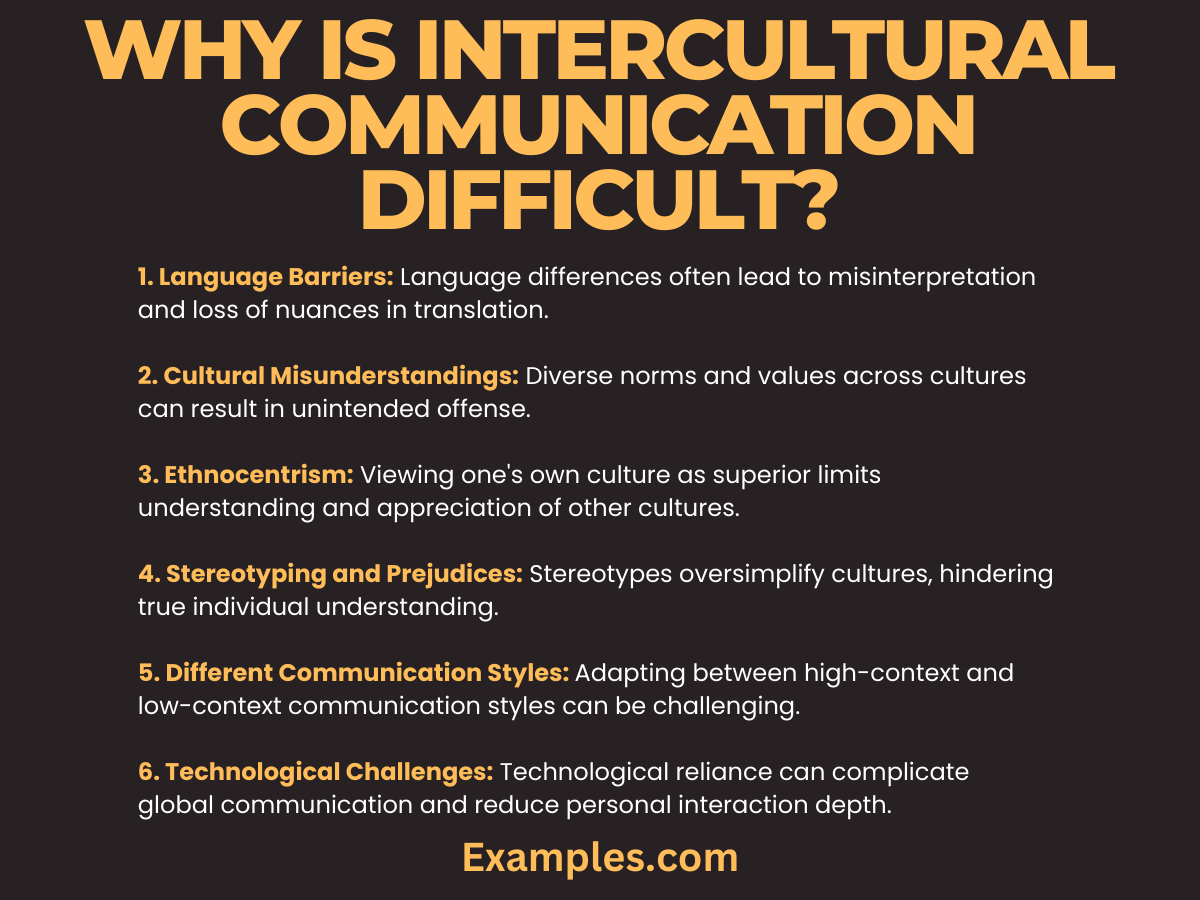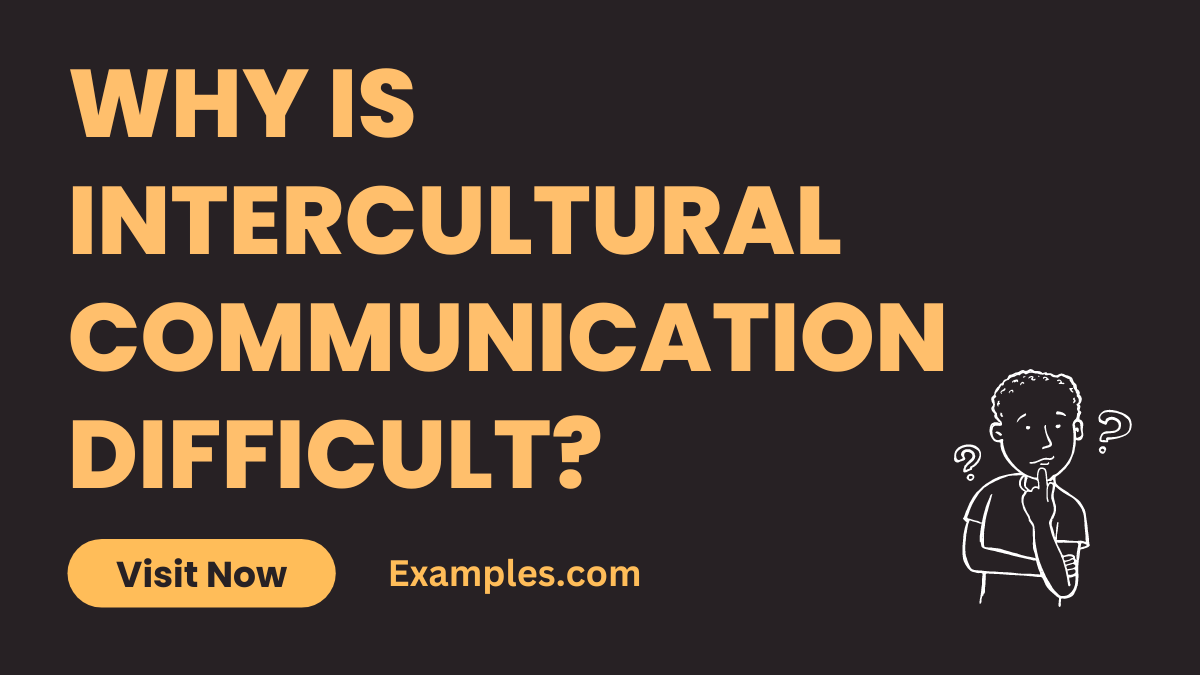Why is Intercultural Communication Difficult?
Understanding why Intercultural Communication can be difficult is crucial in today’s globalized world. This complexity stems from various factors, including language barriers, cultural misunderstandings, and differing communication styles. These challenges often lead to misinterpretations and ineffective interactions among people from diverse cultural backgrounds. Addressing these difficulties requires awareness, adaptability, and a willingness to learn and respect different cultural norms. In this context, exploring the intricacies of intercultural communication not only improves personal and professional relationships but also fosters a more inclusive and understanding global community.
Why is Intercultural Communication Difficult?

Intercultural Communication, the process of sharing information across diverse cultures, presents unique challenges. Understanding these difficulties is key to effective global interactions and fostering mutual respect and understanding.
Language Barriers
- Primary Challenge: Language differences are a major obstacle, leading to misinterpretations.
- Nuances and Context: Even with translation, nuances and contextual meanings can be lost, affecting the message’s integrity.
Cultural Misunderstandings
- Varied Norms and Values: Diverse cultural backgrounds mean differing norms, values, and etiquette.
- Risk of Offense: Unintentional offense can occur due to ignorance of these cultural differences.
Nonverbal Communication Differences
- Importance of Nonverbal Cues: Nonverbal communication varies significantly across cultures.
- Misinterpretation Risks: Misreading body language or gestures can lead to misunderstandings.
Ethnocentrism
- Inherent Biases: Ethnocentrism, or viewing one’s own culture as superior, creates barriers.
- Hinders Openness: This bias can prevent individuals from fully appreciating or understanding other cultures.
Stereotyping and Prejudices
- Oversimplification of Cultures: Stereotypes can lead to oversimplified and incorrect assumptions about others.
- Barrier to Individual Understanding: They hinder the ability to see people as unique individuals beyond their cultural identities.
Different Communication Styles
- High vs. Low Context Cultures: Communication styles can be high-context (indirect and nuanced) or low-context (direct and clear).
- Adaptation Required: Adapting to a style that is not one’s own can be challenging.
Emotional Expressions
- Cultural Expression of Emotions: Cultures differ in how they express emotions, which can affect communication.
- Misunderstanding Emotions: Misinterpreting emotional expressions can lead to incorrect perceptions.
Technological Challenges
- Globalization and Technology: While technology aids global communication, it also presents challenges like time zone differences.
- Dependence on Technology: Reliance on digital communication can strip away the richness of face-to-face interactions.
Recognizing and addressing these challenges is crucial for improving Intercultural Communication. It requires not only language skills but also cultural empathy, adaptability, and a deep understanding of diverse communication styles and norms.
What are the challenges of intercultural communication?
Intercultural communication, though enriching, comes with its own set of challenges, often making interactions between diverse cultures complex.
Linguistic Diversities and Interpretation
- Complexity of Languages: Different languages and dialects can lead to misinterpretation.
- Subtleties in Translation: Nuances often get lost in translation, affecting the intended meaning.
Cultural Norms and Values
- Variations in Norms: Different cultural backgrounds bring unique norms and values that can clash.
- Impact on Interaction: These variations can lead to misunderstandings or unintended offense.
Nonverbal Communication Variances
- Significance of Body Language: Nonverbal cues are interpreted differently across cultures.
- Potential for Misinterpretation: Incorrect reading of body language can lead to communication breakdowns.
Ethnocentric Perspectives
- Bias Towards One’s Culture: Viewing one’s culture as central can create a narrow viewpoint.
- Barrier to Effective Communication: This bias can hinder the appreciation of other cultural perspectives.
Stereotypes and Preconceptions
- Generalizations About Cultures: Stereotypes can oversimplify complex cultural dynamics.
- Hindrance in Personal Connection: Relying on stereotypes prevents genuine understanding of individuals.
Varied Communication Styles
- Contextual Communication Differences: High-context (implicit) and low-context (explicit) communication styles can cause confusion.
- Challenge in Expressing Clearly: Adapting to an unfamiliar communication style can be difficult.
Emotional Expression Differences
- Cultural Expression Variability: Emotions are expressed and interpreted differently in various cultures.
- Risk of Misunderstanding Emotions: Incorrect interpretations can lead to wrong assumptions.
Technological and Logistical Issues
- Global Communication Challenges: Time zone differences and reliance on technology can create barriers.
- Reduced Personal Interaction: Overreliance on digital communication can diminish the richness of direct interactions.
Understanding and acknowledging these challenges is crucial in enhancing Intercultural Communication skills.
Why is it Hard to Communicate with Different Cultures?
Communicating with people from different cultures can be challenging due to fundamental differences in communication styles and cultural understanding.
Diverse Cultural Frameworks
- Differing Worldviews: Cultural backgrounds shape how individuals perceive the world.
- Impact on Communication: These different worldviews can lead to varied interpretations and expectations.
High-Context Versus Low-Context Communication
- Implicit Versus Explicit: Misalignment in communication styles can lead to confusion.
- Navigating the Differences: Understanding and adapting to different styles is key to effective communication.
Emotional Display and Perception
- Cultural Emotional Norms: The way emotions are displayed and perceived varies widely.
- Navigating Emotional Differences: Recognizing and respecting these differences is crucial for effective interaction.
Perceptions of Politeness and Respect
- Cultural Conceptions of Respect: Ideas of politeness and respect differ across cultures.
- Adapting to Cultural Etiquette: Being aware of and adapting to these conceptions is necessary for respectful communication.
Decision Making and Problem Solving
- Cultural Approaches to Decision Making: Decision-making processes can vary significantly.
- Adapting to Different Approaches: Understanding these differences can aid in collaborative problem solving.
Perspectives on Time and Punctuality
- Cultural Time Orientation: Attitudes towards time and punctuality differ culturally.
- Adjusting Expectations: Being flexible and understanding these differences is important.
Communication Through Technology
- Digital Communication Nuances: Technology can both aid and complicate cross-cultural communication.
- Leveraging Technology Effectively: Using technology thoughtfully can enhance understanding and connection.
Understanding why communication with different cultures is challenging helps in developing strategies to bridge these gaps effectively.
What Issues May Cause Communication Difficulties and How can you Overcome Them?
Communication difficulties in intercultural settings are common, but there are strategies to overcome these challenges and enhance understanding.
Recognizing and Respecting Cultural Differences
- Awareness of Cultural Diversities: Acknowledging and respecting differences is the first step.
- Building Cultural Sensitivity: Developing sensitivity towards other cultures aids in better communication.
Developing Cultural Intelligence
- Gaining Cultural Knowledge: Learning about different cultures enhances communication.
- Applying Cultural Understanding: Using this knowledge in interactions improves mutual understanding.
Enhancing Language Skills
- Learning Key Phrases: Knowing basic phrases in another language can bridge gaps.
- Using Clear and Simple Language: Simplifying language and avoiding jargon aids in clarity.
Active Listening and Empathy
- Practicing Active Listening: Carefully listening to understand perspectives is crucial.
- Empathetic Engagement: Showing empathy helps in forming deeper connections.
Seeking Feedback and Clarification (continued)
- Clarifying When Uncertain: Seeking clarification when unsure prevents miscommunications.
- Openness to Learning: Being open to learning from mistakes enhances communication skills.
Utilizing Interpreters or Translation Tools
- Overcoming Language Barriers: Using professional interpreters or reliable translation tools can facilitate better understanding.
- Respecting Linguistic Nuances: Ensuring accurate translation respects cultural and linguistic nuances.
Adapting to Nonverbal Communication Cues
- Understanding Nonverbal Differences: Being aware of different nonverbal signals is key.
- Observing and Adapting: Observing nonverbal cues and adapting responses can improve interactions.
Embracing Flexibility and Adaptability
- Being Flexible in Interactions: Flexibility in communication style and approach is essential.
- Adapting to Situational Needs: Adjusting one’s style to suit the cultural context aids in effective communication.
Promoting Inclusive and Diverse Environments
- Creating Inclusive Spaces: Fostering environments that value diversity encourages open communication.
- Encouraging Diverse Perspectives: Welcoming different viewpoints leads to richer, more effective interactions.
By employing these strategies, individuals and organizations can significantly improve their Intercultural Communication capabilities, leading to more effective and meaningful interactions across cultures.
Cross-cultural communication presents unique challenges but also offers enriching opportunities for learning and connection. This comprehensive guide has explored the complexities, benefits, and strategies for effective Intercultural Communication. Embracing cultural diversity, actively seeking understanding, and adapting communication approaches are key to overcoming these challenges. In our increasingly interconnected world, proficiency in cross-cultural communication is not just a skill but a necessity for fostering global understanding and cooperation.



